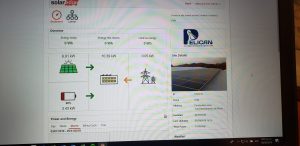I asked Bismarck, the resident director of FunLimon, our family’s community center in Nicaragua, how that “whacky solar power experiment” was going.
He said the panels and related equipment were installed and that the system had been active for nearly two weeks.
“Do we know how well it’s doing?” I asked. “Like how much of FunLimon’s energy it’s going to be supplying?”
“I just got a report from Alan V,” he replied. (Alan V is Rancho Santana’s chief engineer.) “He said that it will be supplying all of it.”
“All of it? Really?”
My longstanding impression of solar energy was that it was costly and inefficient. I knew that progress was being made. But I never expected that these panels, located on top of the roof that covers the basketball court, would be sufficient to power the classrooms, administration buildings, gymnasium, and irrigation system.
Bismarck and I went over the numbers…
It cost $45,000 to install the solar system, including the panels and the batteries and all the equipment. We’ve been spending about $800 a month on electricity at FunLimon. So if the system does indeed provide all the energy we need, the payback will take about five years. After that, the cost of our power will be de minimus– only what it takes to maintain the equipment.
I contacted Alan directly, and he reminded me that the system he had installed a year earlier was now powering most of our company’s buildings at Rancho Santana, including the hotel, clubhouse, restaurant, and a dozen related structures.
I did more research. And it turns out that solar power has come a long way from its crude beginnings 40-odd years ago. Back then, it was, as is often the case with new technology, not just inefficient but very costly. So costly that many predicted it could never compete with fossil fuels. It took almost 30 years to bring the cost down to $8 per watt in 2010. Today, it’s dropped, on average, to about $3 per watt, with some systems producing energy at half that cost.
This astonishing reduction is the result of making solar panels more efficient while, at the same time, reducing their costs. A parallel advancement was made with the batteries that store the energy produced by solar panels.
I saw a PraegerU presentation recently that argued against the effort towards alternative fuels. Fossil fuels, it said, provide 99% of the energy in the world today, and that percentage will not drop by more than a point or two over the next 50 years.
But based on what we are actually experiencing in Nicaragua, I find that hard to believe. If solar panels can pay for themselves in five years at FunLimon and at Rancho Santana, why can’t they do the same for millions of businesses all over the world?
If you are interested in an explanation of our system, you may find the following edifying:
Memo: 5/8/19
From: Alan
To: Mark and Michael
The attached picture is a screenshot of the solar system application at 9:25 a.m., local time.
As you can see on this picture attached the icon means as below:
1) The solar panels are producing 6.91 kw at this time and delivering that power to the facility (FunLimon), see the upper left icon at the screen.
2) The facility is demanding or consuming 10.39 kw of power at this time, see the icon at the center of the screen.
3) The public power company is supplying 0.05 kw, see the icon at the right side of the screen.
4) In order to minimize the utility power consumption, the solar system is providing 3.43 kw to the facility from the battery (see the lower left icon at the screen, the battery charge state at this time is 22%) at this time to compensate for the demand, so if we add 6.91 kw from the panels and 3.43 kw from the battery we get 10.34 kw plus 0.05 kw from the utility power company for a total of 10.39 kw (see item 2).
In other words, right now (at the time of the screen shot) FunLimon is only using 0.05 kw out of total power consumption of 10.39 kw from the public grid, that is only 0.48%. The system is very dynamic and it changes slightly about every 5 seconds as the sun’s intensity and power demand varies….
The protocol is that when the solar panels are producing less than the power demand, the system uses the battery charge to compensate and minimize the use of the public grid. When the solar panels produce more than the power demand the system takes that excess of power and starts charging the battery. The idea is that at the end of the day on a normal sunny day the power consumption during the day from the public grid is going to be minimum and the battery state of charge is going to be 100% to be used at night until it gets 90% discharge….

